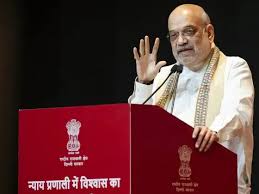New criminal laws biggest reform in independent India: Amit Shah

India has taken a bold step in overhauling its criminal justice system. Union Home Minister Amit Shah declared the new laws—the Bharatiya Nyaya Sanhita (BNS), Bharatiya Nagarik Suraksha Sanhita (BNSS), and Bharatiya Sakshya Adhiniyam (BSA)—as “the biggest reform in independent India.” These new laws replace outdated colonial-era legislation and aim to build a justice system that is timely, transparent, and citizen-focused.
A Shift from Punishment to Justice
The older laws—the Indian Penal Code (1860), the Criminal Procedure Code (1973), and the Indian Evidence Act (1872)—were framed during British rule. Their primary goal was to control the population, not ensure justice. In contrast, the new laws focus on justice, not just punishment.
According to Shah, the reforms center on delivering justice efficiently and ensuring that citizens are treated fairly. For the first time, India is creating criminal laws that reflect its own constitutional values and democratic spirit.
What’s New in the Criminal Law Framework?
The changes are not just symbolic. They include concrete measures to streamline processes, introduce technology, and speed up trials.
1. Technology in Law Enforcement
One of the most significant features is the mandatory use of technology. For instance:
- Crime scenes must be recorded on video for serious offences.
- FIRs can be filed online.
- Courts will send e-summons directly to parties.
In addition, the Nyaya Setu portal allows citizens to track the progress of their cases. This shift helps reduce manual delays and adds transparency to the system.
2. Faster Investigations and Trials
The new laws enforce strict timelines to ensure quicker justice:
- Investigations must conclude within 90 days.
- Trials in serious cases should finish within 60 days of the charge sheet.
- Courts must deliver verdicts within 45 days after the trial ends.
These deadlines reduce pendency and give victims and accused alike more certainty.
3. Updated Definitions and Offences
The new framework addresses modern crimes such as cybercrime, mob lynching, and organized criminal networks. It also removes outdated terms like “sedition” and introduces new language to address threats to national integrity.
4. Community Service and Plea Bargaining
For minor offences, courts may now offer community service as a penalty. The plea bargaining process has also expanded, allowing more people to resolve cases without long trials. As a result, the burden on courts will reduce.
Chandigarh Leads the Way
Chandigarh became the first city in India to fully implement the new criminal laws. The administration trained police officers, introduced digital tools, and launched public awareness campaigns. This move shows that, with preparation, these reforms can be successful on the ground.
What Makes These Reforms So Important?
Home Minister Amit Shah emphasized that these laws are not just legal texts. Instead, they represent a complete transformation of how justice is delivered.
He stated, “India waited 75 years for criminal laws aligned with the Constitution. We have now moved from rule-centric laws to citizen-centric justice.”
These reforms aim to increase conviction rates in heinous crimes by relying on forensic evidence, scientific methods, and digital records. Additionally, the system will become less dependent on oral testimony and reduce the chance of manipulation.
Concerns Remain
Despite the many positives, critics have raised valid concerns:
- Marital rape remains legal, sparking outrage among women’s rights groups.
- The new treason-related provisions are seen by some as vague. Legal experts worry they may be misused to silence dissent.
- Many police stations and lower courts lack the technical training or tools required to follow the new procedures.
Shah acknowledged these gaps. He assured the public that the central government will support states in building capacity and improving infrastructure.
A New Era in Criminal Justice
The new criminal laws mark the beginning of a justice-first approach in India. They offer a modern framework that blends technology with tradition and speed with fairness. While there are challenges to overcome, the intention and scope of the reforms are undeniably bold.
India has now placed justice, not punishment, at the core of its legal system. If implemented well, these changes could finally give citizens what they’ve long demanded—timely, fair, and transparent justice.






